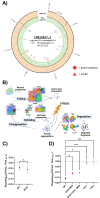Development of heat-shock resistance in Legionella pneumophila modeled by experimental evolution
- PMID: 37668382
- PMCID: PMC10537758
- DOI: 10.1128/aem.00666-23
Development of heat-shock resistance in Legionella pneumophila modeled by experimental evolution
Abstract
Because it can grow in buildings with complex hot water distribution systems (HWDS), healthcare facilities recognize the waterborne bacterium Legionella pneumophila as a major nosocomial infection threat and often try to clear the systems with a pasteurization process known as superheat-and-flush. After this treatment, many facilities find that the contaminating populations slowly recover, suggesting the possibility of in situ evolution favoring increased survival in high-temperature conditions. To mimic this process in a controlled environment, an adaptive laboratory evolution model was used to select a wild-type strain of L. pneumophila for survival to transient exposures to temperatures characteristic of routine hot water use or failed pasteurization processes in HWDS. Over their evolution, these populations became insensitive to exposure to 55°C and developed the ability to survive short exposures to 59°C heat shock. Heat-adapted lineages maintained a higher expression of heat-shock genes during low-temperature incubation in freshwater, suggesting a pre-adaptation to heat stress. Although there were distinct mutation profiles in each of the heat-adapted lineages, each acquired multiple mutations in the DnaJ/DnaK/ClpB disaggregase complex, as well as mutations in chaperone htpG and protease clpX. These mutations were specific to heat-shock survival and were not seen in control lineages included in the experimental model without exposure to heat shock. This study supports in situ observations of adaptation to heat stress and demonstrates the potential of L. pneumophila to develop resistance to control measures. IMPORTANCE As a bacterium that thrives in warm water ecosystems, Legionella pneumophila is a key factor motivating regulations on hot water systems. Two major measures to control Legionella are high circulating temperatures intended to curtail growth and the use of superheat-and-flush pasteurization processes to eliminate established populations. Facilities often suffer recolonization of their hot water systems; hospitals are particularly at risk due to the severe nosocomial pneumoniae caused by Legionella. To understand these long-term survivors, we have used an adaptive laboratory evolution model to replicate this process. We find major differences between the mutational profiles of heat-adapted and heat-naïve L. pneumophila populations including mutations in major heat-shock genes like chaperones and proteases. This model demonstrates that well-validated treatment protocols are needed to clear contaminated systems and-in an analog to antibiotic resistance-the importance of complete eradication of the resident population to prevent selection for more persistent bacteria.
Keywords: Legionella pneumophila; adaptive laboratory evolution; experimental evolution; heat resistance; hot water distribution systems; pasteurization.
Conflict of interest statement
The authors declare no conflict of interest.
Figures




Similar articles
-
Interactions between chaperone and energy storage networks during the evolution of Legionella pneumophila under heat shock.PeerJ. 2024 Apr 30;12:e17197. doi: 10.7717/peerj.17197. eCollection 2024. PeerJ. 2024. PMID: 38708341 Free PMC article.
-
The Tail-Specific Protease Is Important for Legionella pneumophila To Survive Thermal Stress in Water and inside Amoebae.Appl Environ Microbiol. 2021 Apr 13;87(9):e02975-20. doi: 10.1128/AEM.02975-20. Print 2021 Apr 13. Appl Environ Microbiol. 2021. PMID: 33608288 Free PMC article.
-
Legionella Persistence in Manufactured Water Systems: Pasteurization Potentially Selecting for Thermal Tolerance.Front Microbiol. 2017 Jul 19;8:1330. doi: 10.3389/fmicb.2017.01330. eCollection 2017. Front Microbiol. 2017. PMID: 28769899 Free PMC article. Review.
-
Effect of heat shock on hot water plumbing microbiota and Legionella pneumophila control.Microbiome. 2018 Feb 9;6(1):30. doi: 10.1186/s40168-018-0406-7. Microbiome. 2018. PMID: 29426363 Free PMC article.
-
Surveillance of hospital water and primary prevention of nosocomial legionellosis: what is the evidence?J Hosp Infect. 2005 Apr;59(4):273-9. doi: 10.1016/j.jhin.2004.09.031. J Hosp Infect. 2005. PMID: 15749313 Review.
Cited by
-
Exposure of Legionella pneumophila to low-shear modeled microgravity: impact on stress response, membrane lipid composition, pathogenicity to macrophages and interrelated genes expression.Arch Microbiol. 2024 Feb 2;206(2):87. doi: 10.1007/s00203-023-03753-z. Arch Microbiol. 2024. PMID: 38305908
-
Foresight 2035: a perspective on the next decade of research on the management of Legionella spp. in engineered aquatic environments.FEMS Microbiol Rev. 2025 Jan 14;49:fuaf022. doi: 10.1093/femsre/fuaf022. FEMS Microbiol Rev. 2025. PMID: 40424003 Free PMC article. Review.
-
Legionella in Hot Water Heat Pump (HWHP) Systems.Microorganisms. 2025 May 15;13(5):1134. doi: 10.3390/microorganisms13051134. Microorganisms. 2025. PMID: 40431306 Free PMC article. Review.
-
Legionella pneumophila, a Rosetta stone to understanding bacterial pathogenesis.J Bacteriol. 2024 Dec 19;206(12):e0032424. doi: 10.1128/jb.00324-24. Epub 2024 Dec 5. J Bacteriol. 2024. PMID: 39636264 Free PMC article. Review.
-
Interactions between chaperone and energy storage networks during the evolution of Legionella pneumophila under heat shock.PeerJ. 2024 Apr 30;12:e17197. doi: 10.7717/peerj.17197. eCollection 2024. PeerJ. 2024. PMID: 38708341 Free PMC article.
References
-
- Cunha BA, Burillo A, Bouza E. 2016. Legionnaires' disease, p 376–385. In The lancet. Lancet Publishing Group. - PubMed
-
- Kool JL, Fiore AE, Kioski CM, Brown EW, Benson RF, Pruckler JM, Glasby C, Butler JC, Cage GD, Carpenter JC, Mandel RM, England B, Breiman RF. 1998. More than 10 years of unrecognized nosocomial transmission of legionnaires’ disease among transplant patients. Infect Control Hosp Epidemiol 19:898–904. doi:10.1086/647760 - DOI - PubMed
Grants and funding
LinkOut - more resources
Full Text Sources
Molecular Biology Databases
Research Materials

